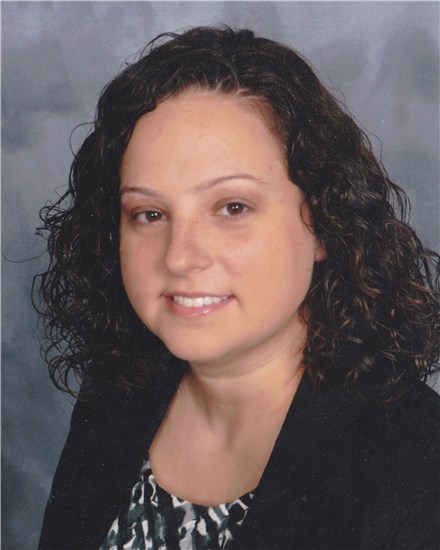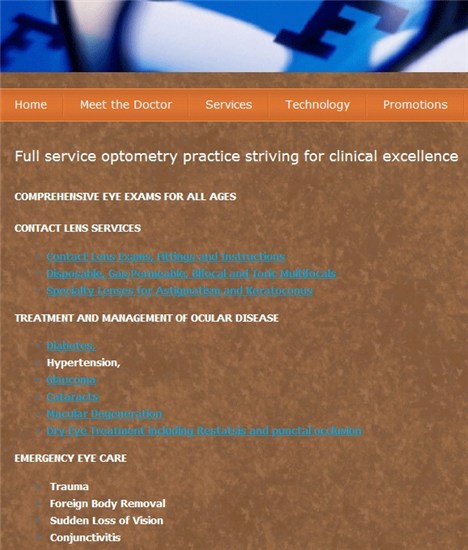By Maria Sampalis, OD

SYNOPSIS
Let patients know you’re the doctor to see for an eye emergency or condition. Then your patients will dial your number when a need arises.
ACTION POINTS
EDUCATE ON MEDICAL EYECARE SERVICES. Let patients know you’re the one to see for issues like conjunctivitis, ocular injury or monitoring of long-term conditions.
LAUNCH BACK-TO-SCHOOL CAMPAIGN. Explain to parents the eye health conditions you monitor for when conducting comprehensive annual exams.
EXPLAIN VALUE OF INSTRUMENTATION. Educate patients about what your instruments do and how they help you care for your patients’ eyes.
Medical eyecare services are the cornerstone of my practice. I take steps every day to ensure my patients know I am the doctor to call or visit when an eye health concern such as conjunctivitis, ocular injury or the need for long-term monitoring of a disease like macular degeneration arises.

A page from Dr. Sampalis’s practice web site detailing the medical eyecare services she provides. Dr. Sampalis recommends using many channels, including your office, web presence, and even local TV news, to publicize your medical eyecare services.
Educate On Medical Eyecare Services
Let patients know you treat red eye or emergency visits so they don’t go to the primary care provider or hospital emergency room. I tell patients while they are in my exam chair about the medical eyecare services we provide, and I give them a magnet with my contact information to serve as a constant reminder.
In addition, we list our services online, including the diseases and conditions we monitor such as glaucoma and diabetic retinopathy. We also have posters in my office to promote eye health with diagrams of the eye and reminders to be examined yearly to maintain eye health. Beyond the exam chair, I stress this message at every patient encounter: “You have a family history of glaucoma, so you need to be seen in our office once a year. We have instruments like a GDX and a visual field screener to closely monitor your eyes.”
Launch Back-to-School Campaign to Educate Parents
Parents usually don’t understand that their child’s eyes need to be monitored more than just when the child can’t see well. When a parent is in our office, I tell them even if their child seems to see well, they still might have a condition such as amblyopia. Parents often think an eye exam at the pediatrician is enough.
We did a back-to-school campaign broadcasted as public service announcements on local television that explained the importance of an annual eye exam for children. My name, along with our practice and office location, were also mentioned, so those watching could look us up and come in for a visit.
Explain Medical Insurance Covers Medical Eyecare Issues
Patients may not be coming to see you for medical eyecare issues like long-term monitoring for glaucoma because they don’t realize that their medical insurance will cover this kind of long-term care at the optometrist’s office. For example, when a diabetic patient comes in for new glasses, I explain that while their vision insurance will cover their new glasses, we’ll be using their medical insurance to cover any costs related to monitoring the affect of diabetes on their eyes.
We take down the patient’s insurance information when they make an appointment, and verify if they are an existing patient, and then, when the patient checks in for their appointment, we explain how much their insurance will cover, and whether their vision or medical insurance, or both, will be applied.
Take Time to Explain Value of High-Tech Instrumentation
Patients see value in high-tech instruments such as OCTs and GDX systems when you explain to them what you will be able to see with the aid of these tools, and what it tells you about their eye health. For example, before using the OCT, you could tell a patient: “Mary, now I’m going to check the health of your retina. The in-depth view I get from this instrument will help me make sure your retina is normal allowing me to check for conditions like retinal detachments and diseases like diabetic retinopathy.”
When you take the time to point out an instrument and explain what you are doing, the patient sees the value in the medical eyecare services you provide. I’ve had patients exclaim, “My last doctor never had that.”
I have a list of patients who are glaucoma suspects, and I sent these patients an e-mail letting them know when I added a GDX instrument to my office. I explained what this instrument is and how it will help me care for their eyes.
Incorporate Medical Eyecare When Prescribing Glasses
Let patients know how the glasses or sunwear you are prescribing will help them from a medical standpoint. For example, when a patient with a family history of macular degeneration is in my exam chair, I prescribe polarized sunwear explaining how UV-protecting polarized sunglasses may help prevent the onset of AMD. I also point out how protecting eyes from the sun with proper sunwear can reduce the patient’s chances of developing cataracts.
Reach Out to Doctors and Community Health Centers
I have sent letters letting local primary care providers know I am here to co-manage patients with them, and I reached out to a local community health center that doesn’t have eye services, and was able to do their diabetic eye exams. This kind of outreach is the right thing to do, but it also helps your practice by letting the community know you’re there.
I also was able to give out my business cards and network with primary care providers at this local community health center, which has a 12,000 patient database.
Search Engine Optimize Medical Eyecare Keywords
In addition to listing the medical eyecare-related technology and services we provide, I use Google Adwords to advertise the keywords “glaucoma check,” “cataracts,” “diabetic eye exam,” as well as “vision exam” for my geographic area. With Google Adwords, you just type in the keywords for your geographic area that you want the search engine to associate with your practice web site, and you’re set.
Pre-Appoint for Annual Exams and Visits to Monitor Long-Term Conditions
At the end of each appointment, whether an annual comprehensive exam or a visit to monitor a disease like macular degeneration or a condition like cataracts, we let the patient know when the doctor would like to see them again and ask them if they would like to set that next appointment while they are still in the office.
If the patient does not want to set their next appointment while still in the office, we send them a postcard a month before their next appointment is due letting them know it is time to call for an appointment.
Related ROB Articles
Getting on Track with the Medical Model: It Begins with Benchmarking
Dry Eye: Meet Growing Patient Needs–and Bill Effectively for Services
Scribes in the Exam Room: Patient Experience & Efficiency Enhancer
Related ROB Videos
Prepare Your Practice to Be Included in ACOs
Train Staff Well for Medical Optometry
AOA ASCO Eye Care Workforce Study
Embrace the Medical Model–But Also Provide Vision Care
Maria Sampalis, OD, is the owner of Sampalis Eye Care in Warwick, RI, and North Dartmouth, Mass, and an adjunct professor at MCPHS University School of Optometry. To contact her: msampalis@hotmail.com



























